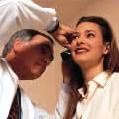
Hearing Specialist Leads Effort to Craft Earwax Guidelines
The age-old advice to routinely clean out earwax is discouraged under the first published guidelines from health care professionals.
"Unfortunately, many people feel the need to manually remove earwax, called cerumen, which serves an important protective function for the ear," said Dr. Peter Roland, the guidelines' lead author and chairman of otolaryngology, head and neck surgery at UT Southwestern Medical Center. "Cotton swabs and some other home remedies can push cerumen further into the canal, potentially foiling the natural removal process and instead cause build-up, known as impaction."
The guidelines recommend professionals use wax-dissolving agents, irrigation or ear syringing, or manually remove it with a suction device or other specialty instrument under supervised care to avoid damaging the ear or further impaction. The guidelines warn against using cotton-tipped swabs, and the home use of oral jet irrigators.
In addition, people with hearing aids should be checked for impaction during regular check-ups because cerumen can cause feedback, reduced sound intensity, or damage the hearing aid, according to the guidelines.
The guidelines were created with input from family practitioners, pediatricians, internists, nurses, audiologists, and emergency room doctors and have been endorsed by the American Academy of Otolaryngology, Head and Neck Surgery.
There are no proven methods for avoiding impaction, according to the analysis, so when should a person seek out a professional?
"When cerumen builds to the point of causing symptoms such as pain, ringing, itching, or hearing problems, it’s a sign you should see a physician,” said Dr. Roland, who also serves as chief of pediatric otology at Children's Medical Center Dallas.
The problem affects one in 10 children, one in 20 adults, and greater than one-third of the elderly and cognitively impaired, according to the academy. About 12 million people annually seek treatment for impacted or excessive cerumen, resulting in nearly 8 million cerumen removal procedures by health care professionals.
"Earwax" is not actually wax, but a water-soluble mixture of secretions produced in the outer third of the ear canal, along with hair and dead skin.
The mixture serves a critical protective function for the ear and shouldn't be removed unless it's causing symptoms or interfering with assessments of the ear, said Roland, who heads to Clinical Center for Auditory, Vestibular, and Facial Nerve Disorders at UT Southwestern.
The guidelines appear in a supplement to the September issue of Otolaryngology – Head and Neck Surgery. They will also be presented at the academy's September meeting in Chicago.
Other conclusions and recommendations include:
- Individuals at high risk for cerumen impaction, such as those who wear hearing aids, should consider seeing a clinician every six to 12 months for routine cleaning;
- Wax dissolving agents are effective, but evidence is lacking regarding the superiority of any particular agent;
- Irrigation or ear syringing is most effective when a wax-dissolving agent is instilled 15 to 30 minutes before treatment;
- Ear candling, an alternative to traditional methods of ear wax removal, doesn’t work, is potentially dangerous and is condemned by the Food and Drug Administration; and
- Manual removal with special instruments under medical supervision is a final option and is preferred for patients with narrow ear canals, eardrum perforation or tube, or immune deficiency.
For more information, visit www.utsouthwestern.org/earnosethroat.